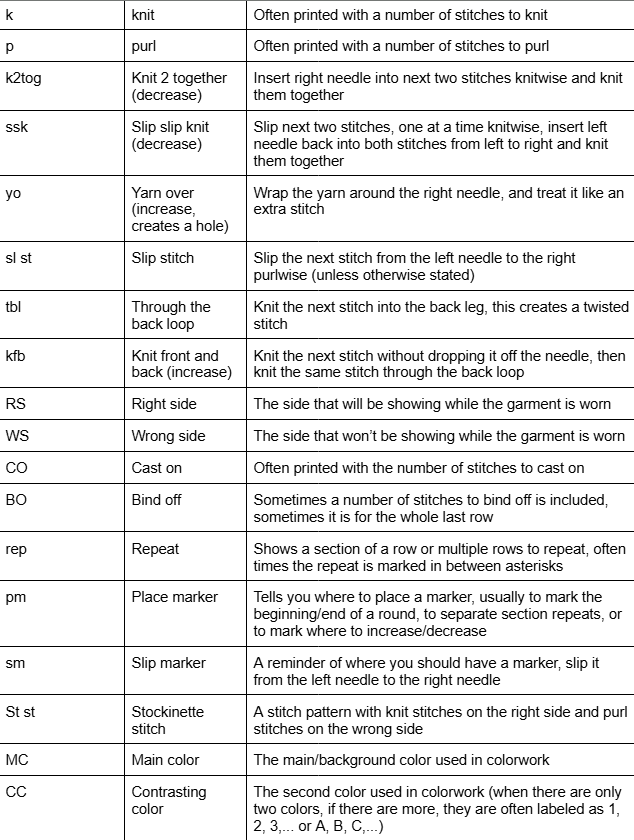Understanding Knitting Patterns
How to read and understand knitting patterns
3/22/20253 min read
Reading knitting patterns can be confusing and daunting at first, but if you can read a recipe, you can read a knitting pattern! I’ll go over typical abbreviations and important information found in patterns and how to interpret them.
Top Matter
Typically at the top of patterns, you will find information about the skill level. Some publications have their own levels but usually will be listed as basic, easy, intermediate, or complex.
Next, you can find the gauge required to get an accurate size, and what yarn the designer used to make the original. Check out my blog post on getting the right gauge here. You will want to match the gauge as closely as possible for accurate sizing.
The yarn information is also important, particularly the weight (thickness) of the yarn and the fiber content. I have a blog post about choosing yarn for your projects here. There will be a list of other materials and notions needed, like a tapestry needle or buttons.
Then you will also see information about sizing, whether it’s for one particular size you’re going for (like for a shawl or a blanket), or multiple sizes for garments. Measurements should be provided for all sizes. Usually, the smallest size is listed first, followed by bigger sizes in parentheses. If there are a lot of different sizes, some designers use a second set of brackets to make it easier to find one particular size. You may still want to highlight the size you’re making throughout the pattern.
If there is a particular stitch pattern to be used in the project, you’ll find that defined here too, along with the stitch multiple. The stitch multiple will tell you how many stitches to repeat and might include some extra stitches for the edges. For example, you might see a stitch multiple of 6 + 2, which means you want a multiple of 6, then add 2 stitches for the edges. You will need to know this if you want a different width and, therefore, the number of stitches to cast on.
Common Abbreviations
Here is a list of commonly used abbreviations in knitting patterns and what they mean:


Note that uncommon stitches and abbreviations will generally be defined and explained before you get to the main instructions of the pattern.
Instructions
The instructions themselves start with the cast on. If it doesn’t specify a particular cast on, you can use whichever one you prefer. If you want some options, check out my blog post with cast-on methods here. From there, it will tell you line by line what stitches to do in each row or round; if you’re knitting flat, the first two rows usually will state which is the right side and which is the wrong side.
As I mentioned in the table, repeats within the same row or round are often marked in between asterisks. It will tell you how many times to repeat the stitch pattern, or you repeat until you have a certain number of stitches left. For example, the instructions may say something like this:
Row 1 (RS): *K1, p1; rep from * k1.
This means you will alternate knit and purl stitches until you have one stitch left, which you knit.
Sometimes parenthesis or brackets are used for repeats within repeats, usually with a specified number of times to repeat it. For example, you might see a line like this:
Row 1 (RS): K1, *k2, (yo, k2tog) 3 times, k2; rep from * k1.
This means you will knit the first stitch, knit the next two stitches, yarn over, knit two together, yarn over, knit two together, yarn over, knit two together, knit two, repeat from the asterisk until the last stitch, which you knit.
If there are any charts, they will usually be included at the end of the main instructions. I plan on writing a future blog post on how to read charts.
Finishing
The finishing instructions come last, and it will tell you what is necessary for finishing after you’ve done the knitting. This could include seaming, weaving in the ends, and blocking (keep an eye out for a future blog post on this). As always, if you have any questions, email me using the form below. Happy stitching!


